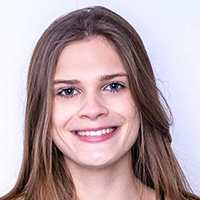By Céline Van Landeghem and Luca Berti
Researchers who study swimming patterns at the microscopic scale seek to understand the propulsion strategies of biological microswimmers and search for potential biomedical applications like targeted drug delivery and cell manipulation. Natural microswimmers, such as bacteria or sperm cells, tend to move in groups within confined liquid environments. Their trajectories are thus influenced by collisions and interactions with the solid walls of their environments.
Our computational framework for microswimming simulation is based on mathematical models for fluid-structure interactions and incorporates a collision algorithm that detects contacts between arbitrarily shaped, strictly convex bodies and convex rigid boundaries. It is able to simulate a wide variety of microswimmers — from rigid, articulated bodies to deformable, flagellated swimmers. We implement the framework via the Feel++ library: an open-source parallel library for the finite element solution of partial differential equations.
We model the process of microswimming as a system of differential equations. First, we use the Stokes equations to describe the dynamics of the Newtonian fluids in a moving domain. The Newton and Euler ordinary differential equations then respectively model the evolution of the swimmer’s linear and angular velocities. Finally, we add a model to account for the swimmer’s strokes. This model is specific to the particular microswimmer in question; its structure can range from analytical expressions to solutions of reduced models or even elasticity equations. The three system components must be connected according to certain coupling conditions, which are always necessary in the context of fluid-structure interaction problems. These conditions impose the continuity between the fluid and the swimmer’s velocities and stresses at the common interface; a geometrical condition also exists between the fluid-solid domains.
Figure 1. Three instances of the position and shape of a sperm cell that propagates a sinusoidal wave along its flagellum over time. The effect of this swimming stroke is straight propulsion in the opposite direction of the traveling wave. Figure courtesy of Luca Berti.
As an example of a fluid-structure interaction, consider several snapshots in the simulation of a three-dimensional sperm cell that is swimming in bulk fluid. Its locomotion results from a sinusoidal planar wave of linearly increasing amplitude that propagates from the cell body to the tip of the flagellum (see Figure 1). We model the stroke by prescribing the swimmer’s deformation velocity, which is given with respect to its reference configuration.
To model the passive interactions between microswimmers and their environment, we add collision forces and torques to the fluid-structure system. The magnitudes of these quantities are partly defined by the distances between the colliding interfaces. To explicitly evaluate the distances, we use a modified version of the fast marching method algorithm [3] that only computes the distance functions within a close neighborhood of the interfaces. This narrow-band fast marching method gives the definition of the collision force by the following repulsive contact-avoidance model:
\[ F^{int} = \left\{\begin{array}{rcl}
0 \;, \quad &\mbox{for }& d_{ij} > \rho , \\
\frac{1}{\epsilon}(\arg\min_{x \in \partial \mathcal{S}_i} D_j(x) - \arg\min_{x \in \partial \mathcal{S}_j} D_i(x))(\rho - d_{ij})^2 \;, \quad &\mbox{for }& 0 \leq d_{ij} \leq \rho .
\end{array}\right.\;\]
Here, \(D_i\in \mathbb{R}^d\) and \(D_j \in \mathbb{R}^d\) are the distance functions from the interfaces of microswimmers \(\partial \mathcal{S}_i\) and \(\partial \mathcal{S}_j\). This expression is a generalization of contact-avoidance models for circular and spherical bodies [1]; the force is activated when the distance \(d_{ij} \in \mathbb{R}\) between the two interfaces is smaller than the length of the collision zone \(\rho > 0\). We compute the direction of the repulsion force by minimizing the distance functions; doing so provides the coordinates of the closest points to each interface, i.e., the contact points. We can then modulate the intensity by setting the parameter \(\epsilon > 0\). If the contact produces a torque on the body, we compute this torque from \(F^{int}\) and the lever arm vector that connects the body’s center of mass with the contact point.
Figure 2. The trajectories of the three spheres as the swimmer approaches a horizontal wall. First, the right (blue) sphere enters the collision zone and the collision torque causes the swimmer to rotate. Similar torques are applied on the center (red) and left (green) spheres as the swimmer approaches the wall, leading to a final orientation that leads the swimmer away from the wall. The figure only depicts the spheres’ centers of mass to increase readability. Figure courtesy of Céline Van Landeghem.
We illustrate our collision model on a three-sphere swimmer [2]—a microswimmer composed of three relatively-moving aligned spheres—that is heading towards a wall (see Figure 2). The swimmer starts from a tilted position. Since its swimming stroke produces only a straight motion, it approaches the wall of the computational domain. Once it enters the collision zone, the combination of collision forces and torques with the constraint on the alignment of the spheres reorients the swimmer, which finally moves away from the wall.
Our computational framework allows us to simulate the swimming strategies of various microswimmers. We are able to add different types of external forces, such as collision or adhesion forces, that enable the simulation of realistic biological phenomena. Moving forward, we are working to incorporate further collision and swimmer models for deformable elastic bodies as well as biological fluid models.
Céline Van Landeghem delivered a minisymposium presentation on this research at the 2023 SIAM Conference on Computational Science and Engineering, which took place in Amsterdam, the Netherlands, earlier this year.
References
[1] Glowinski R., Pan, T.W., Hesla, T.I., Joseph, D.D., & Périaux, J. (2001). A fictitious domain approach to the direct numerical simulation of incompressible viscous flow past moving rigid bodies: Application to particulate flow. J. Comput. Phys., 2, 363-426.
[2] Najafi, A., & Golestanian, R. (2004). Simplest swimmer at low Reynolds number: Three linked spheres. Phys. Rev. E, 69, 062901.
[3] Sethian, J.A. (1996). Level set methods and fast marching methods: Evolving interfaces in computational geometry, fluid mechanics, computer vision, and materials science. In P.G. Ciarlet, A. Iserles, R.V. Kohn, & M.H. Wright (Eds.), Cambridge monographs on applied and computational mathematics. New York, NY: Cambridge University Press.
 |
Céline Van Landeghem is a Ph.D. candidate in applied mathematics at the Université de Strasbourg and is funded by an IRMIA++ scholarship. |
 |
Luca Berti is a research engineer in the Centre Nationale de la Recherche Scientifique and received his Ph.D. from the Université de Strasbourg in 2021. His expertise includes mathematical and computational modeling of multiphysics problems, as well as model order reduction techniques. |